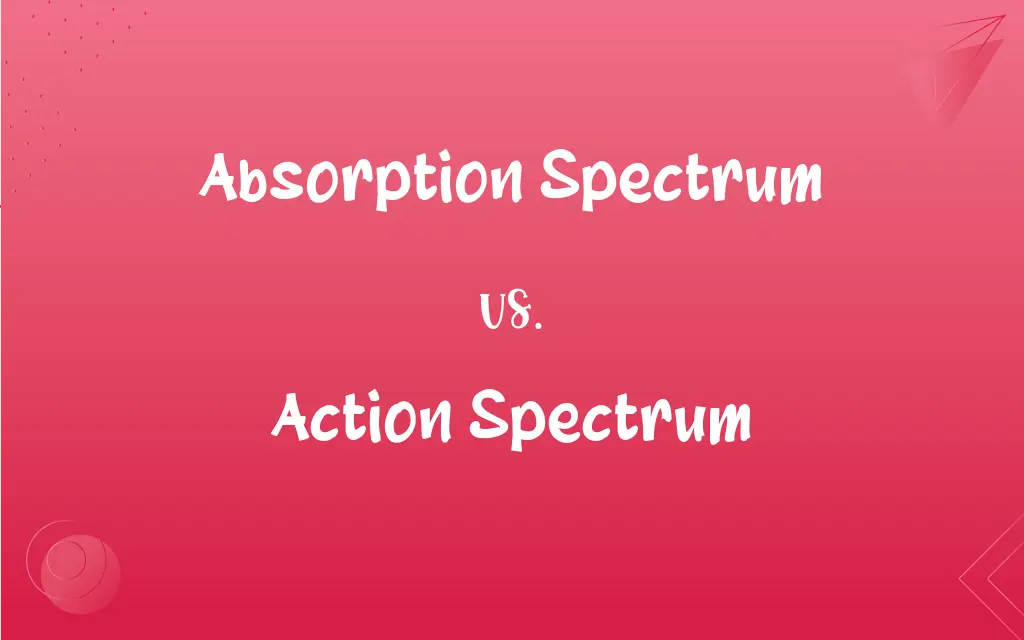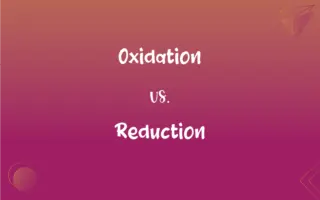Absorption Spectrum vs. Action Spectrum: What's the Difference?
Edited by Janet White || By Harlon Moss || Updated on October 17, 2023
Absorption spectrum shows wavelengths absorbed; action spectrum shows wavelengths triggering a biological activity.

Key Differences
Absorption spectrum refers to a spectrum showcasing the specific wavelengths of light that a substance absorbs. Action spectrum, on the other hand, reveals the wavelengths at which a biological process is most effective.
While absorption spectrum essentially displays a "fingerprint" of a substance based on the light it absorbs, the action spectrum provides insight into how different wavelengths impact a biological response.
In the context of plants, absorption spectrum may detail the wavelengths at which chlorophyll absorbs light most efficiently. Meanwhile, the action spectrum will indicate at which wavelengths photosynthesis occurs at its peak.
It is possible for a substance to have an absorption spectrum showing strong absorption at certain wavelengths, but the action spectrum of a related process may not peak at those same wavelengths.
To illustrate, a pigment might absorb blue light intensely, as seen in its absorption spectrum, but the biological activity it triggers, like photosynthesis, might be most efficient under red light, as evident in its action spectrum.
ADVERTISEMENT
Comparison Chart
Nature
Shows wavelengths absorbed by a substance.
Shows wavelengths where a biological activity is most effective.
Purpose
Identifies "fingerprint" of a substance based on light absorption.
Reveals efficiency of biological processes at specific wavelengths.
Example Usage
In identifying pigments in plants.
In determining peak photosynthetic activity.
Associated With
Materials and chemicals.
Biological processes.
Relationship with Biology
Does not directly indicate biological effectiveness.
Directly tied to a biological outcome.
ADVERTISEMENT
Absorption Spectrum and Action Spectrum Definitions
Absorption Spectrum
A chart displaying how much light a substance takes in across different wavelengths.
Scientists use the absorption spectrum to identify unknown materials.
Action Spectrum
A profile of how different light wavelengths influence a specific biological activity.
The action spectrum for vision differs among nocturnal and diurnal animals.
Absorption Spectrum
A depiction of the light energy absorbed by a substance at varying wavelengths.
The absorption spectrum of a gas can be distinctive, allowing for its identification.
Action Spectrum
A graphical representation indicating the efficiency of a biological process at different wavelengths.
The action spectrum of photosynthesis revealed its highest efficiency under red light.
Absorption Spectrum
A graphical representation of wavelengths absorbed by a substance.
The leaf's absorption spectrum showed peaks in the blue and red regions.
Action Spectrum
A chart showing the effectiveness of physiological responses across various wavelengths.
Studying the action spectrum can help understand which light promotes plant growth.
Absorption Spectrum
The spectrum showing which wavelengths are absorbed by a specific substance.
By analyzing the absorption spectrum, researchers can determine the properties of various pigments.
Action Spectrum
A depiction of which wavelengths are most effective in triggering a certain biological process.
The action spectrum for human skin indicates the wavelengths most responsible for sunburn.
Absorption Spectrum
A profile illustrating light absorption intensity for different wavelengths.
Chlorophyll's absorption spectrum is vital for understanding plant photosynthesis.
Action Spectrum
The spectrum that displays the relative efficacy of different wavelengths in a biological function.
By examining the action spectrum, scientists discerned the best light for algae growth.
FAQs
A chart showing the effectiveness of physiological responses across various wavelengths.
Studying the action spectrum can help understand which light promotes plant growth.
The spectrum that displays the relative efficacy of different wavelengths in a biological function.
By examining the action spectrum, scientists discerned the best light for algae growth.
A graphical representation indicating the efficiency of a biological process at different wavelengths.
The action spectrum of photosynthesis revealed its highest efficiency under red light.
A profile of how different light wavelengths influence a specific biological activity.
The action spectrum for vision differs among nocturnal and diurnal animals.
How does action spectrum differ from absorption spectrum?
While absorption spectrum shows wavelengths absorbed by a substance, action spectrum reveals the wavelengths at which a biological process is most effective.
Does the absorption spectrum indicate how a substance will behave biologically?
No, the absorption spectrum only shows what wavelengths are absorbed; the biological impact is indicated by the action spectrum.
What is an absorption spectrum?
Absorption spectrum is a graphical representation displaying the specific wavelengths of light that a substance absorbs.
Are there technologies that rely on understanding the absorption spectrum?
Yes, technologies like spectroscopy utilize the absorption spectrum for material identification and analysis.
Does the action spectrum change for a process if the organism is modified?
Potentially, genetic or biochemical modifications might shift the action spectrum for certain processes.
A depiction of which wavelengths are most effective in triggering a certain biological process.
The action spectrum for human skin indicates the wavelengths most responsible for sunburn.
Why is the action spectrum important in biology?
The action spectrum provides insight into how different wavelengths impact a specific biological response, aiding in understanding and optimizing processes like photosynthesis.
How is the absorption spectrum useful in research?
The absorption spectrum helps researchers identify and characterize substances based on the light they absorb.
In summary, how do absorption spectrum and action spectrum relate yet differ?
Absorption spectrum displays the light wavelengths a substance absorbs, while action spectrum reveals the efficiency of biological processes at those wavelengths. They relate in the context of light interactions but differ in their implications and applications.
Why might the action spectrum for photosynthesis not align with the absorption spectrum of chlorophyll?
Other pigments and factors can influence photosynthesis, so the most effective wavelength for the process may not match chlorophyll's peak absorption.
Can action spectrum be used in agriculture?
Absolutely, understanding the action spectrum can guide the use of specific light conditions to boost crop yield or growth rates.
Can the peaks in the absorption spectrum and action spectrum for a process be different?
Yes, a substance may absorb light best at certain wavelengths (absorption spectrum) but the associated biological activity might be most efficient at other wavelengths (action spectrum).
Why might a plant biologist be interested in both absorption and action spectra?
Understanding both can help optimize light conditions for growth, as the plant may absorb light best at certain wavelengths but photosynthesize most efficiently at others.
Is absorption spectrum always related to biological processes?
No, absorption spectrum simply shows the wavelengths a substance absorbs, irrespective of any biological outcome.
Can two different substances have similar absorption spectra?
Yes, two substances might have similar absorption patterns, but they can still be chemically distinct.
Can the action spectrum be used for non-plant organisms?
Yes, the action spectrum can be used for any organism to determine the efficacy of biological processes at different wavelengths.
Do all substances have an absorption spectrum?
All substances that interact with light have an absorption spectrum, though it may not always be significant or easy to measure.
How is action spectrum related to human health?
Understanding the action spectrum can guide the use of specific light wavelengths for therapies or highlight harmful wavelengths, like UV causing skin damage.
Can a single organism have multiple action spectra for different processes?
Yes, an organism can have different action spectra for distinct biological activities, like photosynthesis and vision in plants.
Is it possible to predict the action spectrum from the absorption spectrum?
Not always, because the efficiency of a biological process may be influenced by factors other than just light absorption.
Is the action spectrum always tied to a biological outcome?
Yes, action spectrum specifically relates to the effectiveness of biological processes across various wavelengths.
About Author
Written by
Harlon MossHarlon is a seasoned quality moderator and accomplished content writer for Difference Wiki. An alumnus of the prestigious University of California, he earned his degree in Computer Science. Leveraging his academic background, Harlon brings a meticulous and informed perspective to his work, ensuring content accuracy and excellence.
Edited by
Janet WhiteJanet White has been an esteemed writer and blogger for Difference Wiki. Holding a Master's degree in Science and Medical Journalism from the prestigious Boston University, she has consistently demonstrated her expertise and passion for her field. When she's not immersed in her work, Janet relishes her time exercising, delving into a good book, and cherishing moments with friends and family.
































































